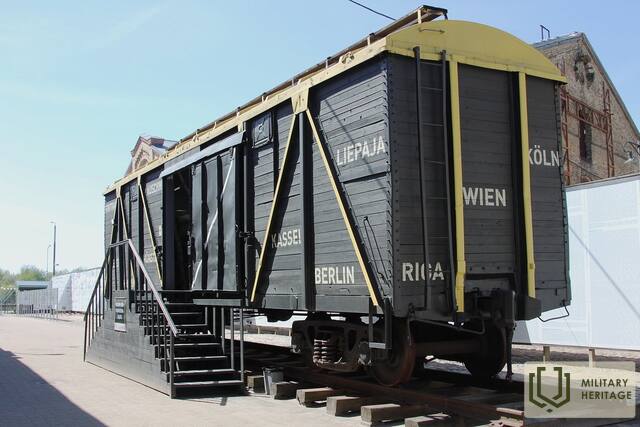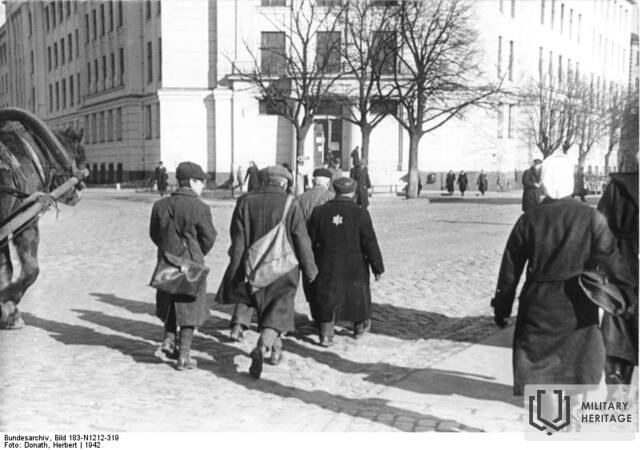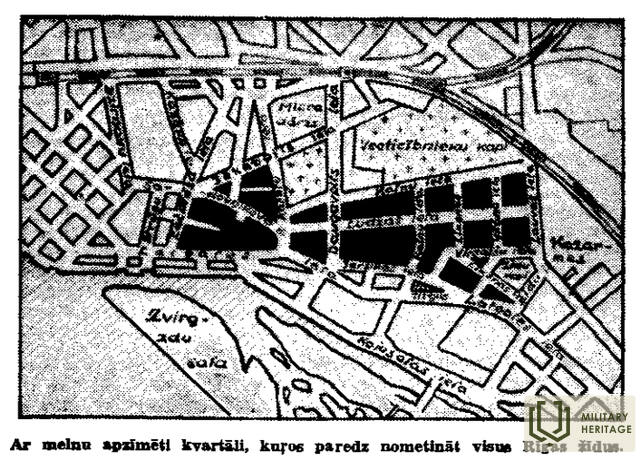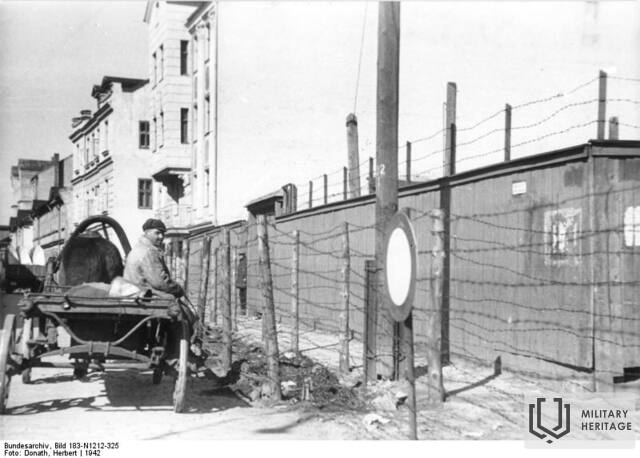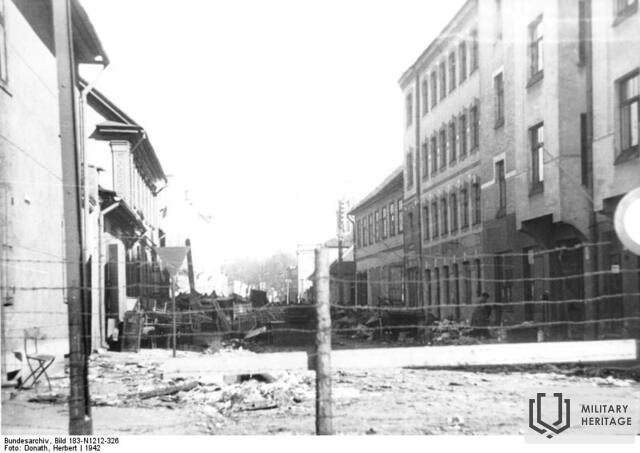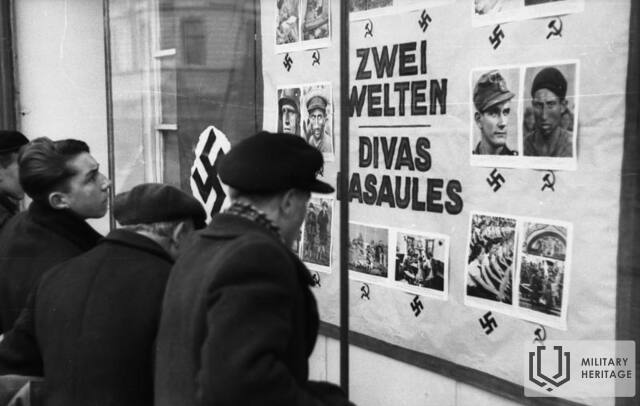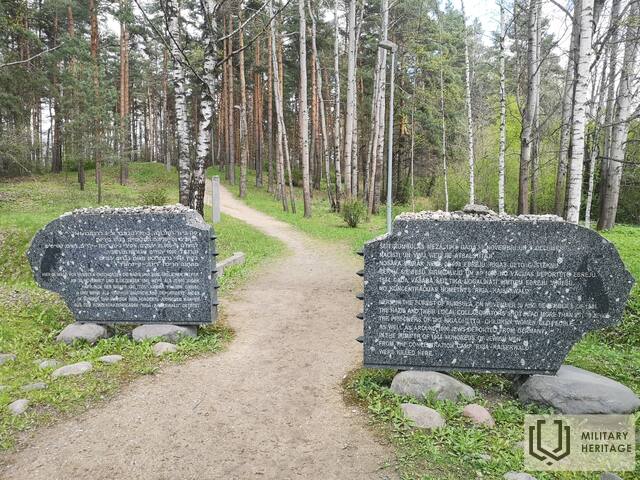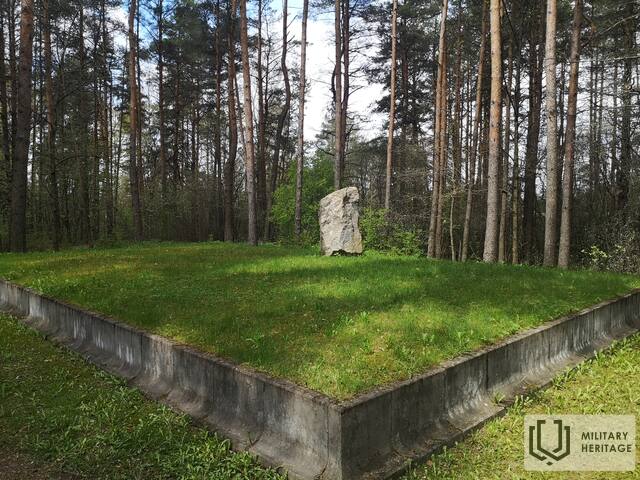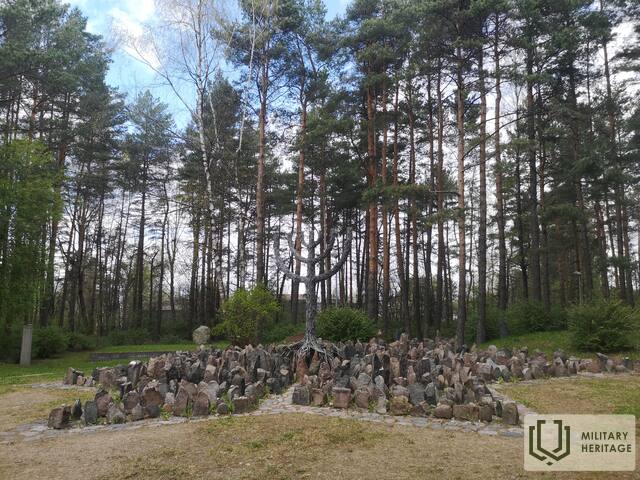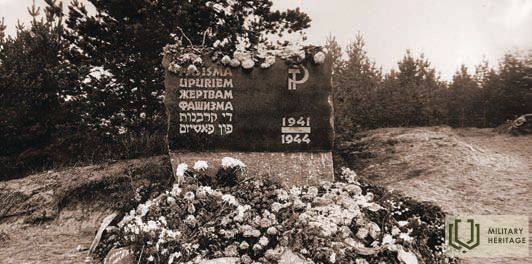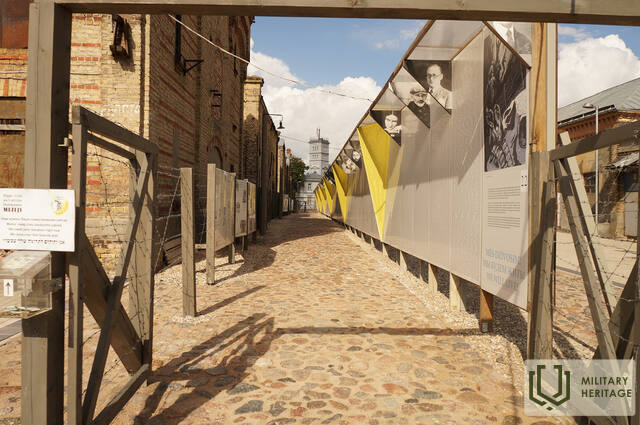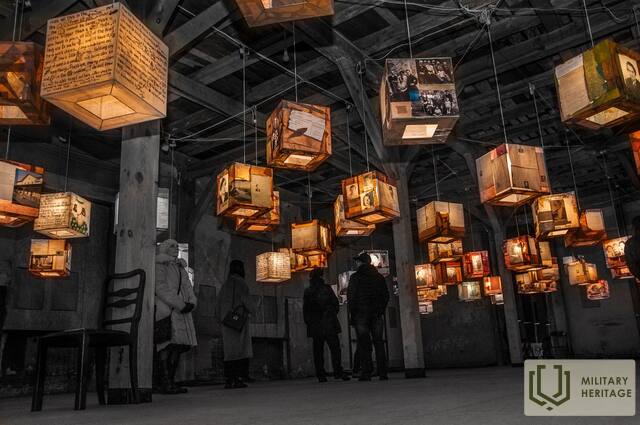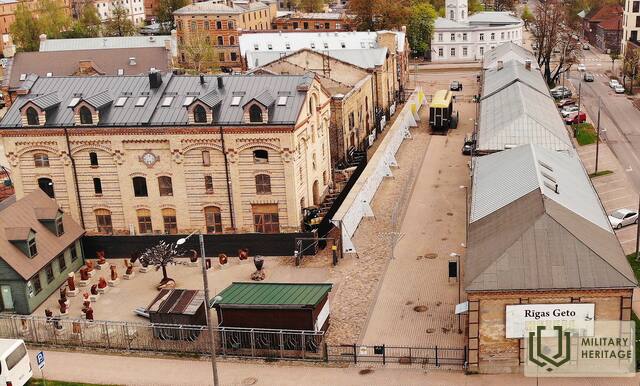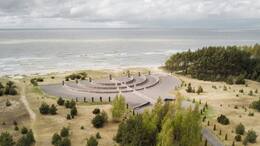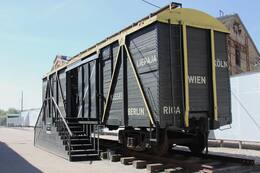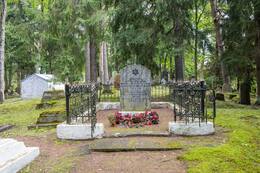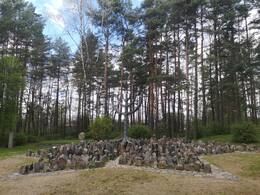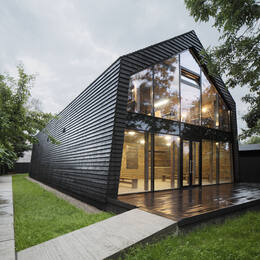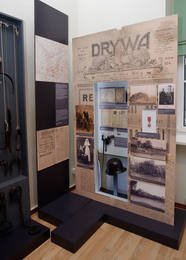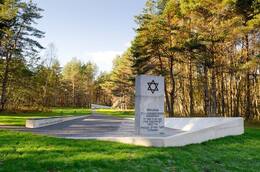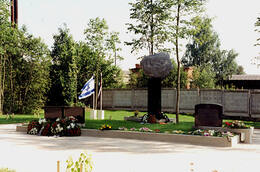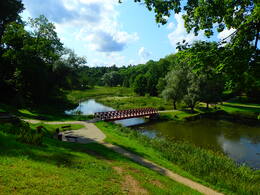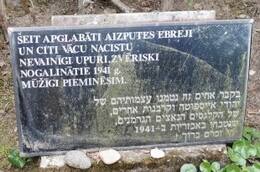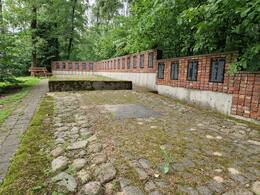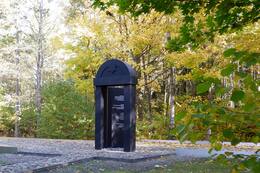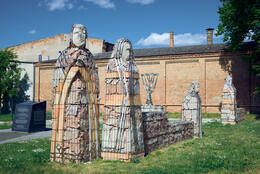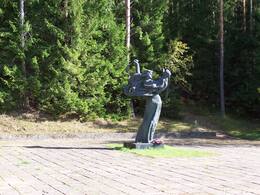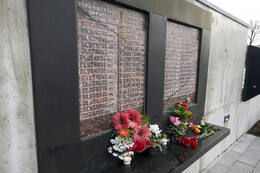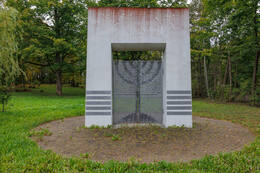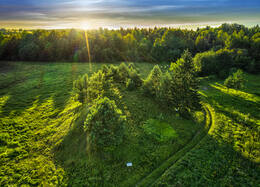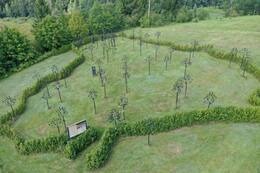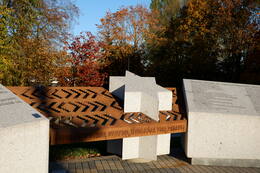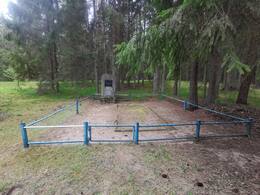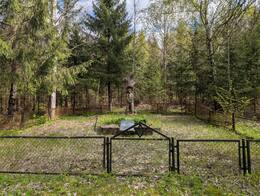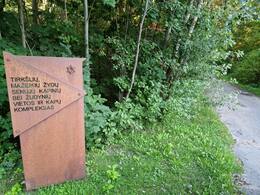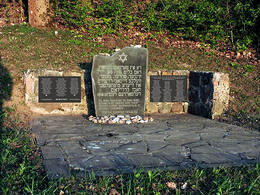Holokaust II Maailmasõda
Holokaust (kreeka keeles holos – kõik, pole jäänuseid; põletati kaustikutes) – juutide massiline hävitamine Natsi-Saksamaal ja selle okupeeritud aladel Teise maailmasõja ajal. Juutide massiline hävitamine algas Poola okupatsiooniga. Saksa invasiooniga Nõukogude Liitu 22. juunil 1941 algas holokausti aktiivne faas. Natside salajane niinimetatud "juutide küsimuse lõplik lahendus" (Endlösung der Judenfrage) oli mõeldud kõigi NSV Liidus elavate juutide tapmiseks. 1930. aastate teisel poolel elas Lätis 93 479 juuti (1935). Lätis tapeti ka suurem osa sõja ajal siia küüditatud Saksa, Austria, Ungari ja Tšehhoslovakkia juute. Genotsiid oli suunatud ka Lätis romade ja vaimuhaigete vastu. Holokaust on suurim tsiviilelanikkonna vastu toime pandud massikuritegu Läti ajaloos – natside okupatsiooni ajal hukkus ligikaudu 73 000 Läti juuti ja 16 000 välismaa juuti.
Holokausti elluviimisega Saksa okupeeritud Lätis tegelesid esialgu Saksa kaitsepolitsei ja SD eriüksus Einsatzgruppe A, mis on neljast sellisest einzaci rühmast suurim. Seda juhtisid SS-brigaadikindral ja politseikindralmajor Walter Stahlecker. Algul kehtestati erinevad piirangud ja keelud, seejärel registreeriti juudid, kes pidid kandma judaismi sümbolit, kuueharulist Taaveti tähte. Juutide vara konfiskeeriti, millele järgnes nende isoleerimine ja lõpuks mõrv. Esimesed mõrvad toimusid 23. juunil 1941 Grobiņas. Saksa sõjaväe- ja tsiviilvõimudel oli vaja kehtestada oma võim ja kaasata tapmistesse kohalik elanikkond. Need toimusid kõigis väikese juutide arvuga asulates. Tapmiste peamised toimepanijad olid Viktors Arāja ja Mārtiņš Vagulānsi juhtimisel spetsiaalselt moodustatud SD üksused.
Juuda kultuse hooned - sünagoogid - põletati maha, juba 4. juulil 19. sajandil Riias. Gogoļa tänava koorisünagoogi teine pool. 23. augustil rajati Moskva eeslinnas geto, mis tervendas 29 602 inimest. 14 000 getot paigutati Daugavpilsi getosse ja mitu tuhat Liepaja getosse. 30. novembril ja 8. detsembril 1941 tapeti tema juhtimisel Rumbulas umbes 25 000 Lätist ja 1000 Saksamaalt toodud juuti. Umbes 6000 juuti sunniti pärast Rumbula veresauna elama. 1944. aastal küüditati ellujäänud Saksamaa laagritesse. Saksa natside okupatsioonivõimud viisid läbi ka genotsiidi Läti romade (romade) liikmete ja vaimuhaigete vastu. Mitmes Läti linnas, Riia, Daugavpilsi, Liepaja, Strenči jm psühhiaatriahaiglates tapeti ligikaudu 2000 romi – ligikaudu 2327 inimest.
Rohkem teabeallikaid
http://okupacijasmuzejs.lv/lv/aktualitates/4-julijs--ebreju-tautas-genocida-upuru-pieminas-diena-379/
Seotud objektid
Holokaustiohvrite memoriaalansambel Liepājas
Läti suurim holokaustiohvrite memoriaalansambel asub Liepājas Šķēde liivaluidetes. Memoriaalansambel on pühendatud rohkem kui 3000 Liepāja juudi mälestusele, kes tapeti Teise maailmasõja ajal. See on Iisraeli rahvussümboli menoraa ehk 7-harulise küünlajala kujuline. Memoriaali kontuur, mida on hästi näha linnulennult, on valmistatud lõhutud kivirahnudest ja graniitplokkidest. Menoraa tuled on valmistatud graniitsammastest, millele on raiutud heebrea, inglise, läti ja vene keeles värsid Jeremija nutulauludest.
Riia Geto- ja Läti Holokaustimuuseum
Riia Geto- ja Läti Holokaustimuuseum asub Riias keskturu ja pearaudteejaama läheduses. Muuseum avati 2010. aastal kohas, kus kunagi asusid linna laod. See on rajatud ajaloolisse linnaosasse, mis piirnes endise juudigetoga. Geto ala on ainulaadne, sest arhitektuuriliselt ei ole see pärast Teist maailmasõda muutunud. See on mälestuspaik juudi rahva tragöödiale. Natsi-Saksamaa poliitika Läti juudi elanikkonna suhtes seisnes 1939. aasta lõpuni selles, et Saksa diplomaadid ja poliitikud üritasid avaldada survet Läti valitsusele juudivastaste meetmete rakendamiseks ja nende vabaduse piiramiseks. Pärast baltisakslaste lahkumist 1939. aastal ei olnud Saksa saatkonnal enam nii head ülevaadet elanikkonna meelsuse ja Lätis toimuva kohta. Kui Punaarmee okupeeris Läti ja hakkas ühiskonnaga manipuleerima, toetas osa juudi elanikkonnast uut okupatsioonivõimu. Pärast seda, kui režiim pöördus terve ühiskonna vastu, langes toetus kiiresti. Ometi oli tekkinud sügav lõhe elanikkonnas, mida püüdis hiljem ära kasutada järgmine okupatsioonirežiim, Natsi-Saksamaa. See lootis, et kohalik elanikkond ahistab ja ründab juute, kuid seda ei juhtunud. Saksamaa töötas välja uue plaani, mis alguses nägi ette Riia geto loomist, aga hiljem hävitas selle elanikud.
Varaklani juudi kalmistu – mälestusmärk saksa-fašistliku terrori ohvritele
Varakļāni juudi kalmistu Kapsētas tänava lõpus.
Varakļāni juudi kalmistul on pärast sõda kaks mälestussammast püstitatud ellujäänud sugulaste ja sugulaste poolt.
Üks neist asub kalmistu piirdeaia lähedal, kus toimus juutide massiline hävitamine. Selle peal olev kiri vene ja jidiši keeles kõlab: "Me leiname igavesti koos oma vanemate, vendade ja õdedega, kes surid 1941. aastal fašistide käe läbi." Teine monument on surnuaia sees; Kohas, kuhu tapetud juudid hiljem ümber maeti, on ka jidiši- ja venekeelne kiri: "Igavene mälestus saksa-fašistliku terrori ohvritest – 4. augustil 1941 julmalt tapetud Varakļāni juutidest".
Natsi-Saksamaa väed sisenesid Varaklani 1941. aastal. Juuli alguses ja esimestest päevadest peale algas juutide piiramine ja üksikud tapmised. Juudi kalmistu lähedale rajati tinglik geto, kuhu kõik juudid pidid kolima. 4. augustil lasi Saksa SD üksus ("Arāja meeskond") kohalike omakaitsejõudude abiga juudi kalmistu territooriumil maha praktiliselt kõik Varakļāni juudid (umbes 540 inimest).
Iga aasta augusti esimesel pühapäeval toimub Varakļāni juudi kalmistul mälestusüritus, mis on pühendatud Varakļānis tapetud juutidele.
Juudi mälestusmärk Rumbulas
Asub Rumbulas Moskava tänava lähedal.
Rumbula on üks suurimaid juutide massilise hävitamise kohti Euroopas. Kahe aktsiooni ajal – 1941. a. 30. novembril ja 8. detsembril, mis realiseerusid natside juhtkonna otsusel Riia getos vangistatud juudid täielikult hävitada, lasti Rumbula metsas maha üle 25 000 inimese, sealhulgas ligikaudu 1000 Saksamaalt küüditatud juuti. 1944. aastal Rumbulas tapeti ka mitusada juudi meest Kaiserwaldi koonduslaagrist.
Esimesed katsed Rumbulas tapetud juutide mälestust jäädvustada pärinevad 60. aastate lõpust. Vaatamata Nõukogude valitsuse piirangutele mõnede juutide initsiatiivil 1963. a. ühele Rumbula männile kinnitati jidišikeelse kirjaga puidust mälestustahvel, Rumbula raudtee äärde (Riia-Moskva liini lähedusse) aga kunstnik Josif Kuzkovskise suur plakat "Juut". Plakatil oli hauast rusikasse surutud mehe kujutis, mis sümboliseerib protesti tehtu vastu. Nii mälestustahvel kui plakat juba 1964. aastal. koristati, kuid juutidel õnnestus saada luba Rumbulasse mälestuskivi püstitamiseks mitte ainult läti- ja venekeelse, vaid ka jidišikeelse kirjaga "Fašismi ohvrid".
aastal 2002 29. novembril avati Rumbulas memoriaalansambel arhitekt Sergejs Riži projekti järgi. Selle loomist toetasid rahaliselt Läti, Iisraeli, USA ja Saksamaa institutsioonid ning eraisikud.
Kiirtee äärde, memoriaali juurde viiva tee äärde on märgiks paigaldatud natsismijõude sümboliseeriv metallkonstruktsioon. Lähedal on kivi seletusega, et seda teed mööda aeti surnuks tuhandeid juute. Mälestusmärgi enda sissepääsu juures on mitmed läti-, inglise-, saksa- ja heebreakeelsete kirjetega kivitahvlid tutvustavad Rumbula tragöödia sündmusi ja mälestussamba rajamise ajalugu. Mälestusmärgi keskosas, Taaveti tähe kujulise väljaku kohal kõrgub seitsmeharuline küünlajalg - menora, mida ümbritsevad kivid, millele on graveeritud Rumbulas tapetud juutide nimed. Endise Riia geto tänavate nimed on raiutud üksikutesse kividesse, millega plats on sillutatud. Mälestusmärgi territooriumil on mitu ühishauda, mille kohad on tähistatud ristkülikukujuliste betoonpiiretega.
Žanis Lipke memoriaalansambel
Žanis (Janis) Lipke memoriaalansambel asub Riias Ķīpsalas. Žanis Lipke Muuseum on tõenäoliselt üks Riia peidetumaid muuseume. Memoriaali varjatud asukoht ei ole juhuslik ja sellel on sümboolne tähendus. See on rajatud kohta, kus Teise maailmasõja aegse Saksa okupatsiooni ajal asus maa-alune peidupaik inimeste päästmiseks. Siin päästsid Žanis Lipke ja tema perekond 55 juuti. Praegune memoriaal on rajatud Žanis Lipke perekonna maja juurde. Memoriaalehitis „Must kuur“ on sümboolne hoone, kus pakuti ja saadi varju. Hoone kujundamisel on saadud inspiratsiooni Ķīpsala kalurite ja meremeeste ajaloolistest tõrvatud hüttidest, mille ehitamisel kasutati pargastest saadud materjale. Seetõttu oli neil väga eripärane värv ja tõrvalõhn. Ainulaadne ei ole ainult selle paiga lugu, vaid ka viis, kuidas muuseum oma külastajatega suhtleb. Üldisel kujundusel on sarnasusi Piiblis kirjeldatud Noa laevaga, samuti meenutab see kaldale tõmmatud ja ümber pööratud paati, mis on oma ülesande täitnud. Memoriaalansambli kontseptsioon tugineb koha ja loo tõesusele ja nendega seotud mälestusesemetele. See on lugu inimese vabadusihast, uskumatust põgenemisest ja usaldusest. Teel muuseumisse on võimalik tutvuda ka Pārdaugava ajaloolise hoonestusega.
Preiļi ajaloo- ja tarbekunstimuuseumi näitus "Muuseumi lood Lätile"
See asub Preiļi kultuurikeskuse ruumides.
Vaadata saab Preiļi Ajaloo- ja Tarbekunstimuuseumi (PVLMM) näitust "Muuseumi lood Lätile" Esimesest maailmasõjast, Vabadussõjast ja Teisest maailmasõjast.
Preiļi Ajaloo- ja Tarbekunstimuuseumi näituse "Muuseumi lood Lätile" (avatud 2018) rubriik "Drywyse lugu" on pühendatud Esimesele maailmasõjale, Vabadussõjale ja Latgale vabastamisele, samuti nagu Lāčplešana sõjaordu rüütlitele. Näituserubriik "Lipu lugu" räägib Teise maailmasõja perioodi rasketest sündmustest, mille käigus preilalasi mõjutasid küüditamised, holokaust, osalemine sõdivate poolte väeosades ja pärast sõda. - rahvuspartisanide ridades. Vaadata saab ka Preiliaadi juutide päästjale Vladislav Vuškānasele antud medalit "Rahvaste õige".
Eelneval avaldusel on ekskursioon vene ja inglise keeles.
Klooga koonduslaager ja holokausti memoriaal
Holokaustiohvrite memoriaal asub Klooga aleviku vahetus läheduses.
1951. aastal püstitati esimene hauamonument, kuid siis kandis see eelkõige sovetliku ideoloogia sõnumit ega mälestanud holokausti ohvreid. 1994. aastal asendati Eesti juudi kogukonna palvel hauamonumendi mälestustahvlid uutega, millega seati jalule õiglus ohvrite rahvuse osas. Klooga massimõrva 50. aastapäevaks avati olemasolevast hauamonumendist 100 m kaugusel mälestusmärk aastatel 1941–1944 Eestis mõrvatud juutidele. 2005. aastal pandi Kloogale kolmas mälestusmärk, millega meenutatakse Klooga koonduslaagris mõrvatud või surnud juute.
Memoriaali uuendati põhjalikult 2013. aastal, sidudes tervikuks sinna varem eri aegadel püstitatud mälestusmärgid ning avati Eesti Ajaloomuuseumi välinäitus „Klooga laager ja holokaust“.
Klooga koonduslaager asutati Saksa okupatsioonivõimu poolt septembris 1943. Tegemist oli sunnitöölaagriga, mis kuulus Vaivara laagrite süsteemi Eestis. 19. septembril 1944. a toimus Kloogal üks suuremaid massimõrvu Saksa okupatsiooni aegses Eestis, kui Punaarmee lähenedes hukati kõik sel ajal laagris olnud ligi 2000 juuti.
Preiliuse holokausti memoriaal
See asub Preiļu juudi kalmistul Cēsu tänaval.
Mälestusmärgi arhitekt on Sergejs Riž. Avatud 8. augustil 2004. aastal. Mälestusmärk ehitati endise Preiļi elaniku, inseneri ja avaliku töölise Dāvid Zilbermanise (USA) initsiatiivil ja isiklikel vahenditel. 2015. aastal lisati memoriaalile veel üks monument - kalmistu sissepääsu juurde paigaldatud kaar sümboolse värava kujul.
Mälestusmärk asub Preiļi juudi kalmistu serval, koha kõrval, kus 1941. aasta suvel tapeti pärast Natsi-Saksamaa vägede sisenemist kohalike kollaborantide osalusel umbes 800 Preiļist ja selle lähiümbrusest pärit juuti. Toonastest sündmustest annab tunnistust Preiļi juudi tüdruku Sheina Grami (1926-1941) päevik, mida ta hakkas kirjutama 22. juunil - päeval, mil algas NSV Liidu ja Saksamaa vaheline sõda - kuni 8. augustini. Sheina koos oma perekonna ja teiste ellujäänud Preila juutidega tapeti juudi kalmistu kõrval 9. augustil. Tänu preilast pärit Vladislavas Vuškānase (1887-1953) abile õnnestus 6 Preila juudil end varjates Saksa okupatsiooni üle elada. Monumendi kividele on graveeritud sissekanded Sheina Grami päevikust, aga ka tänusõnad juutide päästjale Vladislav Vushkanile. Monumendi jalamile on maetud urn 750 siin tapetud juudi nimedega.
Misiņkalnsi sõjalise pärandi rada
Misiņkalnsi looduspark asub Aizpute linnas. Misiņkalns on Aizpute linna kõrgeim koht. Selle kõrgus ulatub 95,4 meetrini. Ülevalt avaneb maaliline vaade linnale. Misiņkalnsi loodusparki hakati rajama 20. sajandil. Esiteks. Pargi pindala on hetkel ca 28 ha.
Pargi territooriumil asuvad mitmed 20. sajandi sündmustega seotud kohad ja mälestusmärgid - Läti vabadussõdades langenud sõdurite mälestusstele - Lāčpleši ordu kavalerid, holokausti mälestusmärgi koht, represseeritute mälestuspaik ja langenud partisanide mälestustahvel.
Pargis saab tutvuda erinevate haruldaste liikide taimede ja istandustega ning nautida puutumatut loodust. Praegu läbivad parki renoveeritud kõnni- ja rattateed ning pargi territooriumil on motorada, kus toimuvad Läti motokrossi võistlused.
Misiņkalnsi mõisapargi kultuuri- ja ajaloopärandi põhjalikumaks tundmaõppimiseks soovitame kasutada giidi teenuseid.
Holokausti ümbermatmispaik
Natsiväed sisenesid Aizputesse 1941. aastal. 28. juunil. Juba juuli alguses lasti Dzirkali metsas ja linnapargis maha osa juute, ülejäänud linna ja lähiümbruse juudid arreteeriti ja paigutati kahte linna sünagoogi.
Pärast seda toimus kahe aktsiooni käigus juutide massiline tapmine.
Tänaseks on ümbermatmispaika paigaldatud monument heebrea- ja lätikeelse kirjaga: "Siia on maetud Aizpute juudid ja teised Saksa natside süütud ohvrid, kes tapeti 1941. aastal julmalt. Me mäletame igavesti."
Kaušėnai holokausti memoriaal
Kaušėnai holokausti ohvrite mälestusmärk on paigaldatud Kaušėnai külla (Plungė rajoon) juutide veresauna paika. Mälestusmärk on pühendatud Teises maailmasõjas hävinud Plunge ja seda ümbritsevate külade juudi kogukonna mälestusele.
Mälestusmärk rajati viimase Plunge juudi Jakov Bunka initsiatiivil. Esimene monument püstitati 1952. aastal. Teise maailmasõja ohvrite eest ning 1986.–1989 rajati ka tammepuust monumentidest mälestusmärk surnud juutide austamiseks. aastal 2011 paigaldati mälestussein, mis ehitati lammutatud Plunge sünagoogi 1800 tellisest, millest igaüks on pühendatud mõrvatud inimese mälestusele, ning plaadile on kinnitatud plaadid 1200 (1800-st) juudi teadaolevate nimedega. seina. Mälestusmärgi juurde on loodud Päästjate allee, kus eraldi nimeveergudel on kirjas natside okupatsiooni ajal Plunges ja selle ümbruses hukkamõistetud juute päästnud isikud.
aastal 1941 12.-13.juuli Kaušėnai mäele tapeti ja maeti Plunge piirkonnast umbes 1800 juuti, keda oli varem 2 nädalat jõhkrates tingimustes Plunge sünagoogis hoitud. Genotsiidipäeval sõidutati need, kes suutsid kõndida, kõndima 5 km hukkamispaika, teised veeti veoautodega eraldi rühmadena. Ohvritel kästi kaevata endale augud, misjärel nad tulistati. Teine rühm pidi surnud matma ja endale uue augu kaevama.
Mälestusmärk on Euroopa juudi rahvuse tragöödiat kajastavate kõige muljetavaldavamate mälestusmärkide esikümnes.
Juutide holokausti toimumispaik Šeduvas Pakuteniy külas
Pakuteni metsas (Radviliški rajoon), Šeduvast umbes 8 km kagus, kruusatee ääres, asub üks kolmest Šeduva juudi holokausti paigast.
Selles kohas 1941. a augustis tapeti 27 juuti, sealhulgas Sheduva viimane rabi Mordechai David Henkin. Vahepeal hukkus rahvametsas veel umbes 700 inimest.
Pärast seda, kui natsid 25. juunil 1941 Šeduva okupeerisid, aeti linna juudid juuli alguses sunniviisiliselt kodudest välja ja aeti naaberkülla Pavartyčiai, kus rajati geto. 25.-26.augustil lasti väike osa neist maha Pakuteniis, ülejäänud Liaudiškii metsas.
2014-2015 Šeduva Juudi Mälestusfondi eestvõttel puhastati tapatalgud ja tehti külastajatele juurdepääsetavaks. Pakuteniy juutide veresauna kohale on paigaldatud skulptor Romo Quintuse monument "Swiesas žvaigdas bveinė".
Šeduva juutide 1. ja 2. holokausti paigad
Šeduva I ja II holokausti paigad asuvad Liaudiškių metsas (Radviliškise rajoon), Šeduvast umbes 10 km edelas. Kruusateele on paigutatud huviväärsus.
Esimene juudi rahvusest inimeste säilmete kalmistu asub 375 m² suurusel alal, mida ümbritseb mets, millest suurem osa on kivisillutisega. Selles kohas tapeti ja maeti umbes 400 inimest. Umbes 500 m kaugusel asub teine surnuaed. Juudi rahvusest inimeste säilmed on maetud 144 m² suurusele alale. Platsi reljeef on tasane, suurem osa territooriumist on samuti kivisillutisega. Selles kohas tapeti ja maeti umbes 300 inimest.
aastal 1941 neis paikades tapeti kogu Šeduva juudi kogukond – ligi 700 inimest. Enne seda veetsid nad veel kuu aega Pavartyčiai külla rajatud getos. 25-26 august Geto elanikud viidi Rahvametsa. Väljakaevatud kaevu juures hoiti hukkamõistetuid, kelle tapsid kohalikud politseinikud ja valgekraed.
2014-2015 Šeduva Juudi Mälestusfondi eestvõttel koristati tapatalgud ja tehti külastajatele juurdepääsetavaks. Siin on 2 skulptor Roman Quintuse monumenti: "Uks" ja "Tähekiir".
Mälestusmärk "Sünagoogi aed"
See asub Bauska kesklinnas, Bauska piirkonna turismiinfokeskuse, Raekoja platsi lähedal.
Mälestusmärk "Synagogas dārzs" sündis tänu Bauska juudi järeltulijate initsiatiivile Iisraelis, USA-s ja Suurbritannias, annetustele, Bauska maanõukogu, Läti juudi koguduste ja kogukondade toetusele.
Mälestusmärgi kujundas skulptor G. Mustkunstnik, kes on ka V. Plūdonise monumendi autor. Mälestusmärk loodi endise Bauska Suure sünagoogi mõõtmetes, kivifiguurid sümboliseerivad pärast jumalateenistust sünagoogist väljuvaid juute. Mälestusmärgi keskel on sümboolne bima, millele on kirjutatud: "Pühendus Bauska juutidele, kes elasid siin sajandeid ja ehitasid selle linna ning kelle tapsid natsid ja nende kohalikud abilised 1941. aastal." Juudi rahva – Bauska juutide järeltulijate ja Bauska elanike mälestuse austamine. 1935. aastal elas Bauskas ligi 800 juuti. Pärast natside okupatsiooni juulis 1941 arreteeriti, küüditati palju juute ja umbes 700 lasti maha. Bauska Suur sünagoog hävis Teise maailmasõja ajal.
Anchupani memoriaal Teise maailmasõja ohvritele
Pühendatud natside okupatsiooni ajal tapetud Rēzekne rajooni elanikele. Alates 1941. aasta augustist lasti Ančupani mägedes maha Rēzekne ja selle ümberkaudsete külade juute, kommunistliku okupatsioonirežiimi toetajaid, punaarmeelasi jne. Hukkunute seas oli ka 203 Makašēni valla Audriņu küla elanikku, kes tapeti 3. jaanuaril 1942. aastal.
Mälestusmärk avati 27. juulil 1974. aastal. Selle autor on maastikuarhitekt Alfons Kišķis (1910–1994). Igihaljad kuused paremal pool teed sümboliseerivad mahalaskmiseks rivistatud inimesi, tee vastaspoolne kiviaed laskureid. Kõige madalamas osas - kannatuste orus - viib mahalastud inimeste ühishaudadest mööda kividega kaetud tee, mis lõpeb betoonseinaga, millel on kiri "They died to live you". Edasi tuleb trepp Dzīvības väljakule, mille kesksel skulptuuril "Õunema" on autor skulptor Rasa Kalniņa-Grīnberga (1936).
Audriņi küla ohvrite mälestuspaik
1965. aastal avatud mälestustahvel endise Rēzekne vangla juures. Pühendatud Makašēni valla Audriņi küla kolmekümnele mehele, kes 4. jaanuaril 1942 selles kohas avalikult maha lasti. Plaadile on graveeritud 30 mahalastud mehe nimed.
Veidi enne seda selgus, et Audriņi külas varjasid end põgenenud Punaarmee sõjavangid. Nende tabamisel puhkenud relvastatud kokkupõrgetes hukkus 4 abipolitseinikku. Intsidendi eest kättemaksuks andsid natside okupatsioonivõimud korralduse tappa kõik Audriņi elanikud ja küla põletada. Avalik hukkamine Rezeknes oli osa kättemaksukampaaniast.
Holokausti memoriaal
2004. aasta augustis avati Preiļis Cēsu tänaval holokausti ohvrite mälestusmärk. Arhitekt Sergejs Rižs, idee autor ja rahastaja on aga USA elanik Dāvids Zilbermanis. Mälestusmärk asub juutide tsiviilhaudade ja juudi elanikkonna laskepesade vahelisel alal.
Esimesed juudid saabusid Preiļisse 19. sajandi alguses, kui hakati moodustama Preiļi linna. 1935. aasta rahvaloenduse andmetel olid Preiļi 1662 elanikust 847 (51%) juudid. Enamik neist olid kaupmehed, käsitöölised, aga ka intelligents – arstid ja õpetajad.
Kui Saksa natsiarmee sisenes 1941. a 28. juulil, 9. ja 10. augustil hävitati üle 720 Preiļi ja lähiümbruse juudi. Pärast sõda naasis osa juute Preilisse, kuid kogukonda ei õnnestunud üles ehitada.
2013. ja 2014. aastal viisid juudi kodanike kalmistul läbi Saksa noorteühenduse LOT õpilased ja selle juht Klaus Peter Rex. Koostati kalmistu kaart. 2015. aastal avati Dāvid Zilbermanise eestvõttel tema rahastuse ja annetuste toel juudi kogukonnale mälestuskaar Preiliis, juudi kodanike kalmistu sissepääsu juures, teel holokaustiohvrite memoriaali juurde.
2018. aastal tegi ühendus "Preiļu memoriaalid" (esimees Sergejs Rižs) kaevetöid juutide tapmispaigas juudi kodanike kalmistu kõrval. Avastati kolm süvendikohta. Pärast konserveerimist saab esemelisi tõendeid vaadata Preiļi ajaloo- ja tarbekunstimuuseumi põhinäitusel aadressil Rainiš bulvāri 28. Muuseumi spetsialistid pakuvad külastajatele haridusprogrammi "Mõelda holokaustile tähendab mõelda iseendale". Programm algab muuseumi ekspositsioonist ja lõpeb holokausti memoriaali juures. Mälestusmärki koos kalmistuga kasutatakse rahvahariduses vabaõhumuuseumina.
Žydų holokausto vieta Kražiuose (prie Medžiokalnio)
Medžiokalnio kalno papėdėje šalia Kražių miestelio yra Kražių žydų žudynių vieta ir kapas.
Prieš Antrąjį pasaulinį karą Kražių miestelyje gyveno apie 1500 žmonių, iš kurių apie 80 žydų šeimų – 450-500 žydų kilmės gyventojų. 1941 m. Kražių žydai buvo izoliuoti dvaro daržinėje įrengtame gete (į jį vėliau pateko taip pat iš Karklėnų atvežti žydai) ir per kelis etapus išžudyti.
Naciai aktyviai stengėsi įtraukti į holokaustą lietuvius: sušaudant žydus, vokiečių karininkai siekė, kad kiekvienas į mišką kaip konvojininkas atvykęs policininkas, sukilėlis, partizanas arba baltaraištis nušautų bent vieną savo kaimyną ar pažįstamą žydą. Po 1941 m. įvykdytų žudynių iš Kražių žydų bendruomenės liko apie 20 asmenų, kurie slapstėsi Lietuvoje arba pasitraukė į SSRS gilumą.
1941 m. rugpjūčio 2 d. nacistai ir jų talkininkai prie Medžiokalnio nužudė daugiau nei 70 vaikų ir kelis suaugusius žydus. Šias žudynes istorikas Stanislovas Buchaveckas pavadinęs „Žydų vaikų išžudymu“.
Šiuo metu šioje vietoje stovi paminklas su iškaltu užrašu: „Šioje vietoje 1941.08.02 nacistai ir jų talkininkai nužudė 71 Kražių žydą“. Užrašas hebrajų kalba pažymi, kad buvo nužudyti 71 Kražių žydas: 6 vyrai ir moterys, 65 vaikai.
Litvaki mälestusaed
Žemaitija rahvuspargis Medsedžiai külas, umbes 2 km kaugusel Plateliai linna keskusest, Jakov Bunka heategevus- ja toetusfond 2014.a. asutas litvaki mälestusaia. See monument on pühendatud hävitatud Leedu juudi kogukondade mälestusele.
12 aakri suurune aed jäljendab Leedu piirjooni ning sepistatud metallist õunapuudega on tähistatud juudi kogukondade hävitamise kohad aastatel 1941-1944. Sepistatud õunte autor on Artūras Platakis. Õunad puudel – pered, kes elasid kogukondades. Litvakad üle maailma saavad aia loomisele kaasa aidata, tellides oma esivanemate mälestuseks uusi õunapuid ja õunu. Aeda püstitatakse ka Karjala graniidist sambaid, et üksikult austada litvakate saavutusi maailmas.
aastal 2016 seda algatust laiendati – õunapuid kasutati kogu Leedu Suurvürstiriigi leedulastest ja juutidest päästjate mälestuseks holokausti ajal. Aia sissepääsu juures olev stend räägib arvuliselt Leedu endistest juudi kogukondadest.
Hetkel on aias juba "kasvanud" õunapuu Alytuse, Alsėdžii, Kalvarija, Mosėdise, Platelia, Plungė, Telšiai, Vabalninka, Viekšnii jt juudi kogukondade mälestuseks.
Rahvaste Õigete väljak (monument)
aastal 2021 22. oktoober Šiauliais avati Ežero ja Vilniuse tänavate ristmikul Rahvaste Õiglaste väljak. See on esimene rahvaste õiglaste monument Leedus. Monumendi autor on projekteerija Adas Toleikis Šiauliaist ja algataja Šiauliai maakonna juudi kogukonna esimees Sania Kerbelis.
Loodud monumendil "Jungtis" on Šiauliai maakonna rahvaste õigete nimed, mälestades 148 juudi päästjat, ning kunstilised aktsendid tähistavad Šiauliai geto väravate asukohti. Šiauliai linna rajati kaks getot: nn Kaukazo kvartalisse ja Ežero–Trakų tänavale. veerand. Esimesse getosse saadeti füüsiliselt tugevad ja heas vormis isikud, teise - spetsialistid (arstid, mehaanikud jt). Šiauliai geto asutati 1941. aastal. suvel Šiauliai linna sõjaväekomandandi korraldusel ja likvideeriti 1944. aastal, kui Natsi-Saksamaa taganes ning järelejäänud juudid toimetati Stutthofi ja Dachau koonduslaagritesse. Rohkem kui 5950 juuti oli getodes vangis. Sõdade vahelisel ajal elas Šiauliais umbes 6500-8000 juuti, osa neist siirdus vabatahtlikult Venemaa sügavustesse ja pärast holokausti jäi alles umbes 350-500 juudi päritolu elanikku.
Kražių žydų holokausto vieta Kuprės miške
Kuprės miške apie 13 kilometrų nuo Kražių miestelio yra Kražių žydų žudynių vieta ir kapas.
Prieš Antrąjį pasaulinį karą Kražių miestelyje gyveno apie 1500 žmonių, iš kurių apie 80 žydų šeimų – 450-500 žydų kilmės gyventojų. 1941 m. vasarą Kražių žydai buvo izoliuoti dvaro daržinėje įrengtame gete.
1941 m. liepos 26 d. įvyko masinės Kražių žydų žudynės Kuprės miške. Sunkvežimiais apie 300 suaugusiųjų ir jaunuolių buvo nuvežta į mišką. Operacijos metu žydai buvo rikiuojami grupėmis ir sodinami į sunkvežimius. Keliaujant į žudynių vietą, buvo perduoti kastuvai – ženklas, kad aukos turės iškasti duobes. Kuprės miške žydai iškasė gilią pailgą duobę. Vėliau jie buvo priversti nusirengti, o egzekucija vyko organizuotu būdu: aukos buvo statomos po penkis prie duobės krašto, šaudoma dviem eilėmis – pirmoji šaudė į nugarą ar krūtinę, antroji – į galvą.
Žudynes vykdė tiek vietos TDA (Tautinio darbo apsaugos) būrio nariai, tiek vokiečių kareiviai ir karininkai. Žudynės užtruko dėl sugedusio sunkvežimio ir pasipriešinimo Kražių gete, kai kaliniai suprato, kad išvežtieji nebegrįžta. Dėl šių aplinkybių tą pačią dieną nebuvo įvykdyta planuota 12 sovietų aktyvistų egzekucija. Šie asmenys vėliau buvo pervežti į Raseinių kalėjimą ir dauguma jų buvo paleisti.
Vokiečių saugumo pajėgos po žudynių konfiskavo žydų turėtus vertingus daiktus. Operacijos rezultatas – beveik visi Kražių žydų bendruomenės nariai, vyresni nei 12 metų, buvo sunaikinti.
Šiuo metu holokausto vietoje stovi paminklas, o žudynių duobės vieta yra aptverta tvorele.
Šateikių holokausto aukų kapai
Salantų žydų bendruomenės moterų ir vaikų žudynių vieta ir kapas -istorinės holokausto aukų kapinės šiaurės vakarinėje Plungės rajono savivaldybės teritorijos dalyje, Šateikių Rūdaičiuose (Platelių seniūnija), 0,5 km į šiaurės rytus nuo kelio Skuodas-Klaipėda, Šateikių girios šiaurės vakariniame pakraštyje.
Kapavietė stačiakampio plano, 10 x 10 m dydžio, apjuosta vielos tinklo tvora. Jos šiaurės vakarinėje dalyje įrengti metaliniai, ažūriniai, vienvėriai varteliai, kurių viršutinėje dalyje pavaizduota Dovydo žvaigždė. Paminklinėje granito plokštėje iškalta Dovydo žvaigždė bei memorialinis užrašas jidiš ir lietuvių kalbomis. 1980 m. pastatyta medinė skulptūra, vaizduojanti stovintį žydą surištomis rankomis (autorius – tautodailininkas Jakovas Bunka). Teritorijos plotas – 0,01 ha.
Šioje vietoje 1941 m. liepos–rugpjūčio mėn. Salantų ir Šateikių pagalbiniai policininkai žudė Salantų žydų bendruomenės moteris ir vaikus. Egzekucija vyko trimis etapais. Pirmosios žudynės įvyko apie 1941 m. liepos 20 d. Policijos nurodymu paryčiais prie Salantų sinagogos, kurioje buvo laikomos žydės su vaikais, iš kaimų atvyko vežikai su vežimais, kurie, lydimi pagalbinių policininkų, į Šateikių girią išvežė apie 60–70 moterų. Antrųjų žudynių metu liepos mėn. pabaigoje buvo nužudytos paskutinės gete likusios daugiau kaip 50 moterų su vaikais. Rugpjūčio mėn. pabaigoje pagalbiniai policininkai į Šateikių girią konvojavo sušaudymui apie 100 Salantų žydų moterų, kurios nuo liepos mėn. dirbo pagalbinius žemės ūkio darbus Šalyno dvare ir pas Salantų valsčiaus ūkininkus.
Holokausto Lietuvoje atlaso duomenimis čia palaidotos 95 aukos. Kapavietės paminklinėje lentoje ir dokumentų rinkinyje „Masinės žudynės Lietuvoje“ nurodyta, jog čia žuvo 100 žydų vyrų, moterų ir vaikų. Salantų istorijos tyrinėtojas Paulius Vaniuchinas nustatė, kad šioje vietoje buvo nužudyta 210–220 moterų ir vaikų.
Žudynių ir laidojimo vieta 1970 m. paskelbta vietinės reikšmės istorijos paminklu, 1993 m. registruota kultūros vertybių registre.
Mažeikių ir jų apylinkių žydų žudynių vieta
Objektas yra prie senųjų Mažeikių žydų kapinių. Važiuojant Sedos gatve (164 keliu) iš Mažeikių link Tirkšlių/Sedos, kairėje kelio pusėje stovi ženklas „Žydų genocido ir II-ojo pasaulinio karo aukų kapavietė“.
Iki Holokausto pradžios, 1940 m. liepos 1 d., Mažeikių mieste gyveno apie 1 100 žydų. 1941 m. birželio pabaigoje, prasidėjus vokiečių okupacijai, iki 1 000 žydų buvo suimti ir laikomi Mažeikių sinagogoje. Liepos viduryje Leckavos žydai – apie 40 žmonių – buvo uždaryti į Lačo daržinę Mažeikiuose, moterys ir vaikai – daržinėje, o vyrai – sinagogoje.
1941 m. liepos 29 d. į Mažeikius atvykę vokiečiai vertė žydus kasti duobes prie žydų kapinių, o liepos 30 d. 6 val. ryto prasidėjo masinės žudynės. Pirmą dieną šaudė vokiečiai, vėliau žudynes tęsė vietos baltaraiščiai. Rugpjūčio pradžioje prie tų pačių kapinių sušaudyti ir žydai iš kitų valsčių bei tarybiniai aktyvistai.
1944 m. gruodžio 7 d. sovietų komisijos nurodymu buvo atkasti kapai ir atlikta teismo medicininė ekspertizė. Konstatuota, kad už 3 km nuo Mažeikių, ant Ventos upės kranto, žydų kapinėse rastos 5 kapavietės, kuriose užkasta apie 4000 palaikų. Prie Mažeikių sušaudytų žydų skaičius nurodomas skirtingai – nuo 3000 iki 4000. Istoriniai tyrimai leidžia teigti, kad šie skaičiai padidinti – aukų būta apie 2500.
Šiuo metu objektas yra lankytina vieta, kurią gali aplankyti visi besidomintys karinio paveldo istorija.
Juutide veresauna koht ja hauad Platelias (Jazmínu kalnas)
Jazminų mägi, mis asub Plateli linna ääres. Mäe jalamil 1941. a juulil 30 Platelia juuti lasti maha (osa Platelia juute lasti maha Laumalenki poolsaarel). Sõdade vahel elas Platleis umbes 100 juuti, kuid „[…] kõigi saatus on sama. Alguses, nagu tavaliselt, kogusid nad mehed kokku, siinsamas Platelia lähedal, näete, kus monument seisab – seal nad tulistasid nad maha. Paari nädala pärast viisid nad naised, lapsed ja vanurid siia, Platelia poole, mõne kilomeetri kaugusele metsa ja lasid nad kõik seal maha,» rääkis holokausti üle elanud Jakov Bunka poeg Eugenijus Bunka.
Umbes 1985. aastal tema isa, rahvakunstnik Jakovs Bunka, nikerdas ja asetas mäele dekoratiivse Moosese skulptuuri. aastal 2016 skulptuur varises kokku, 2018 ehitati rahvakunstnik Antanas Vaškise nikerdatud koopia.
Mäe jalamile on juutide genotsiidi mälestuseks püstitatud ka graniidist mälestusplaat, millel on jidiši ja leedukeelsed kirjad: „Siin valati 30 juudi – laste, naiste, meeste – verd. Natsionalistid ja nende kohalikud toetajad mõrvasid nad julmalt juulis 1941. Olgu süütute surnute mälestus püha." aastal 2019 veel kaks graniitplaati, millele on lisatud 1939. a. Plateleis elanud juutide nimekirjaga.
Seotud lood
Riia geto ja holokaust
Teadlikult on valitud kolm fragmenti erinevate inimeste mälestuste lugudest, mis võimaldavad holokaustikuritegevust lähemalt vaadelda erinevatest vaatenurkadest.
Taaveti täht Dundaghi koonduslaagri mälestusmärgil
Pärast taasiseseisvumist paigaldasid Dundaga elanikud juutide mõrva- ja ümbermatmispaika Mazirbe - Dundaga maantee äärde suure puust Taaveti tähe ning hiljem avas Läti Juudi Koguduste ja Koguduste Nõukogu selle kõrval mälestuskivi. seda.
Mees, kes päästis tagakiusatu
Bronius Gotautas, keda rahvas tunneb Broliukina, riskis Teise maailmasõja ajal ja pärast seda oma eluga, et päästa tagakiusatud inimesi – nii juute, Leedu rahvuslasi kui ka Vene sõdureid.
Armastuslugu, mis lõppes sõjaga
See lugu räägib Pranas Laucevičiuse ja Rūta Gurvičiūtė armastusest ja ellujäämisvõitlusest Teise maailmasõja ajal. See annab tunnistust julgusest, ohverdustest ja surmast, kui sõja julmused lämmatasid riigipiirid, kuid mitte inimlikud tunded.
Nagu oleks teist korda sündinud
1941 Juulis ja augustis tapsid natsivõimud Kražiais peaaegu kogu linna kogukonna. Kražiai geto vang ja K. Požėla kolhoosi kolhoosnik Marytė Gerčienė pääses sellest tragöödiast imekombel.
Salantai juudi naiste veresaun Šateikiai metsas
1941 1941. aasta suvel toimus Šateikiai metsas juudi naiste ja laste veresaun, mille korraldasid kohalik politsei ja valgekraed. Ohvrid transporditi Salantai'st veresauna sündmuskohale ning enne mahalaskmist kästi neil riided seljast võtta ja kaevatud auku hüpata. Erinevate allikate kohaselt tapeti nende hukkamiste käigus 95–230 inimest, kellest enamik olid naised ja tüdrukud.
Mažeikiais lõpetas oma elu 2500 õnnetut hinge
1941. aasta juuli lõpus algasid Mažeikiais juutide massimõrvad, mille algatasid sakslased ja mida hiljem jätkasid kohalikud valgekraekurjategijad. Inimesed viidi gruppidena juudi kalmistule, sunniti riided seljast võtma ja lasti maha kaevatud aukude lähedal. Mõne päeva jooksul mõrvati Mažeikiaist ja selle ümbruskonna linnadest üle 2000 juudi.
Leedu päästjad - Miriam Javnaitė-Voronova ellujäämislugu
Teise maailmasõja ajal elas Miriam Javnaitė-Voronova holokausti üle tänu paljudele leedulastele, kes oma ja lähedaste elusid riskides varjasid, toitsid ja hoolitsesid tagakiusatud juutide eest.
Šarnelė külaelanike vägiteod
Teise maailmasõja ajal päästsid kaks Šarnelė küla perekonda – Striaupiaid ja Kerpauskasid – surmaohust hoolimata juutide elud. Striaupiaid päästsid koguni 26 inimest, sealhulgas üheksa perekonda, ning Kerpauskaste talu metsa rajati peidupaik Alsėdžiai juudi köösneri perekonnale.
Plateliai juutide tragöödia
1941. aasta juulis mõrvati Plateliai linnas Jazminų mäel 30 kohalikku juuti ning hiljem sai see paik meeldejäävaks seal aset leidnud traagiliste sündmuste poolest.
Plungė juutide saatus
1941. aasta suvel hävitati Plungės jõhkralt peaaegu kogu kohalik juudi kogukond, mis koosnes enam kui 1800 inimesest. Inimesi vangistati kohutavates tingimustes, näljutati surnuks ja lõpuks lasti Kaušėnai metsas maha. Massimõrvad panid toime kohalikud kaastöölised.




